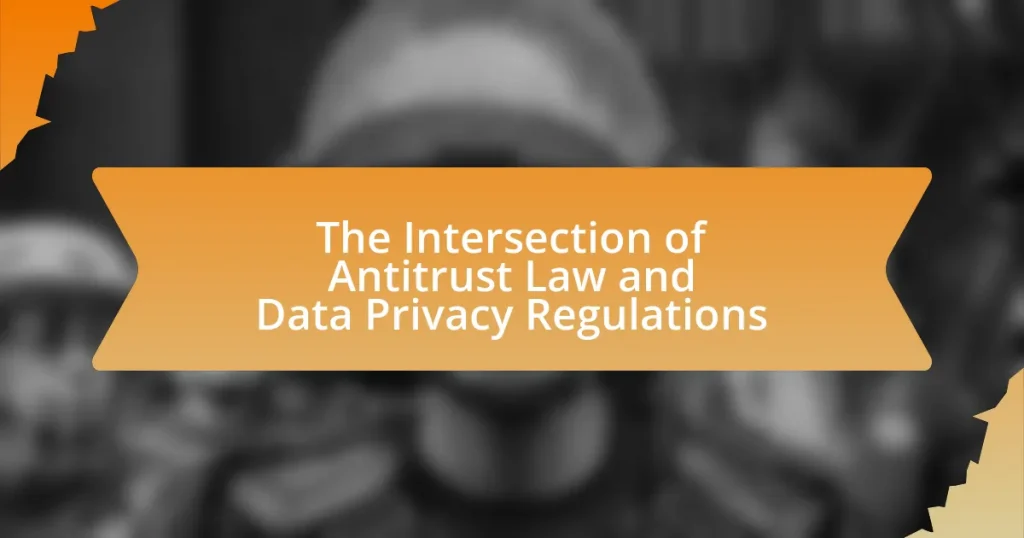The article examines the challenges of regulating emerging technologies under antitrust law, highlighting issues such as rapid innovation, complex digital markets, and difficulties in defining market power. It discusses how emerging technologies differ from traditional markets, complicating antitrust regulation due to factors like network effects and data-driven business models. The article emphasizes the importance of antitrust law in promoting competition and preventing monopolistic practices, while also addressing the limitations of current frameworks in adapting to the unique characteristics of digital platforms. Additionally, it explores the implications of data ownership, mergers, and international cooperation in enhancing antitrust enforcement in the tech sector.

What are the key challenges of regulating emerging technologies under antitrust law?
The key challenges of regulating emerging technologies under antitrust law include the rapid pace of innovation, the complexity of digital markets, and the difficulty in defining market power. Rapid innovation often outpaces existing legal frameworks, making it hard for regulators to keep up with new business models and practices. The complexity of digital markets, characterized by network effects and data-driven competition, complicates the assessment of anti-competitive behavior. Additionally, defining market power in these contexts is challenging, as traditional metrics may not apply, leading to uncertainty in enforcement actions. These challenges hinder effective regulation and enforcement of antitrust laws in the face of evolving technologies.
How do emerging technologies differ from traditional markets?
Emerging technologies differ from traditional markets primarily in their rapid pace of innovation and disruption. Unlike traditional markets, which often evolve gradually and are characterized by established players and stable business models, emerging technologies introduce new products and services that can quickly reshape industries. For instance, the rise of digital platforms like Uber and Airbnb has transformed transportation and hospitality sectors almost overnight, challenging existing regulatory frameworks. This swift change creates unique challenges for antitrust law, as regulators must adapt to the dynamic nature of these technologies, which often operate in a global context and leverage network effects that traditional markets do not.
What characteristics of emerging technologies complicate antitrust regulation?
Emerging technologies complicate antitrust regulation due to their rapid evolution, network effects, and data-driven business models. The rapid pace of innovation often outstrips existing regulatory frameworks, making it difficult for regulators to assess market power accurately. Network effects create situations where the value of a service increases as more users join, leading to monopolistic tendencies that are hard to identify and regulate. Additionally, data-driven business models can obscure competitive practices, as companies leverage vast amounts of consumer data to gain an advantage, complicating the assessment of anti-competitive behavior. These characteristics necessitate a reevaluation of traditional antitrust approaches to effectively address the unique challenges posed by emerging technologies.
How does rapid innovation impact market definitions in antitrust law?
Rapid innovation significantly alters market definitions in antitrust law by creating dynamic competitive landscapes that challenge traditional assessments of market power. As new technologies emerge, they can redefine existing markets or create entirely new ones, complicating the identification of relevant product and geographic markets. For instance, the rise of digital platforms has led to debates over whether to classify them as distinct markets or as part of broader categories, such as advertising or retail. This complexity is evidenced by cases like the Federal Trade Commission’s scrutiny of Facebook, where the rapid evolution of social media and its integration with advertising necessitated a reevaluation of market boundaries. Consequently, antitrust authorities must adapt their frameworks to account for these shifts, ensuring that they effectively address anti-competitive behavior in rapidly changing environments.
Why is antitrust law important for regulating emerging technologies?
Antitrust law is crucial for regulating emerging technologies because it prevents monopolistic practices that can stifle innovation and competition. As new technologies develop, dominant firms may engage in anti-competitive behaviors, such as predatory pricing or exclusive contracts, which can hinder smaller competitors and limit consumer choices. For instance, the Federal Trade Commission’s actions against tech giants like Google and Facebook illustrate how antitrust enforcement aims to maintain a competitive marketplace, ensuring that innovation continues to thrive. This regulatory framework is essential to foster a diverse technological landscape that benefits consumers and promotes economic growth.
What role does antitrust law play in promoting competition?
Antitrust law plays a crucial role in promoting competition by preventing monopolistic practices and ensuring a level playing field for businesses. These laws prohibit anti-competitive agreements, such as price-fixing and market allocation, which can stifle competition and harm consumers. For instance, the Sherman Act of 1890 established the foundation for antitrust enforcement in the United States, leading to significant cases like the breakup of Standard Oil in 1911, which demonstrated the law’s effectiveness in dismantling monopolies and fostering market competition. By regulating mergers and acquisitions that could reduce competition, antitrust law helps maintain diverse market options for consumers, ultimately driving innovation and economic growth.
How can antitrust law prevent monopolistic practices in tech industries?
Antitrust law can prevent monopolistic practices in tech industries by promoting competition and prohibiting anti-competitive behavior. These laws, such as the Sherman Act and the Clayton Act in the United States, empower regulatory bodies to investigate and challenge mergers, acquisitions, and business practices that may reduce market competition. For instance, the Federal Trade Commission (FTC) and the Department of Justice (DOJ) have the authority to block mergers that would create monopolies or significantly lessen competition, as seen in the 2020 case against Facebook, where the FTC sought to break up the company due to its monopolistic practices in social media. Additionally, antitrust laws can impose penalties on companies that engage in practices like price-fixing, exclusive contracts, or predatory pricing, which can stifle competition and innovation in the tech sector.
What are the limitations of current antitrust frameworks in addressing emerging technologies?
Current antitrust frameworks struggle to effectively address emerging technologies due to their reliance on outdated economic models and definitions of market power. These frameworks often fail to account for the rapid pace of innovation and the unique characteristics of digital markets, such as network effects and data monopolies. For instance, traditional antitrust analysis typically focuses on price effects and consumer harm, which may not adequately capture the competitive dynamics in tech sectors where free services and data control are prevalent. Additionally, the global nature of technology companies complicates jurisdictional enforcement, as seen in cases involving multinational corporations that operate across various legal systems. These limitations hinder regulators’ ability to adapt to new business models and ensure fair competition in an increasingly digital economy.
How do existing antitrust laws fail to account for digital platforms?
Existing antitrust laws fail to account for digital platforms primarily because they are based on traditional market definitions that do not capture the unique characteristics of digital ecosystems. Digital platforms often operate in multi-sided markets, where value is created through interactions between different user groups, complicating the assessment of market power. For instance, the U.S. antitrust framework typically relies on price effects and consumer harm, but many digital services are offered for free, making it difficult to apply these criteria effectively. Additionally, existing laws do not adequately address issues like data monopolization and network effects, which can lead to entrenched market positions that stifle competition. This inadequacy is evident in cases like the Federal Trade Commission’s challenges against Facebook, where the complexities of user data and platform interconnectivity were not fully addressed under current antitrust statutes.
What challenges arise from the global nature of technology markets?
The global nature of technology markets presents challenges such as regulatory discrepancies, market access barriers, and intellectual property issues. Regulatory discrepancies arise because different countries have varying laws and standards, complicating compliance for multinational companies. For instance, the European Union’s General Data Protection Regulation (GDPR) imposes strict data privacy requirements that differ significantly from those in the United States, creating challenges for companies operating in both regions. Market access barriers can occur due to protectionist policies or trade restrictions, limiting the ability of foreign firms to compete effectively in local markets. Additionally, intellectual property issues, including varying enforcement of patents and copyrights across jurisdictions, can hinder innovation and lead to disputes. These challenges necessitate a nuanced approach to antitrust regulation that considers the complexities of a global marketplace.

What specific issues arise when applying antitrust law to emerging technologies?
Applying antitrust law to emerging technologies presents specific issues such as defining market boundaries, assessing market power, and addressing rapid innovation cycles. Defining market boundaries is challenging because emerging technologies often create new markets or disrupt existing ones, making it difficult to determine relevant competition. Assessing market power is complicated by the unique characteristics of digital platforms and network effects, where a few dominant players can emerge quickly. Additionally, the rapid pace of innovation can outstrip regulatory responses, leading to outdated frameworks that fail to address current market dynamics. These issues highlight the need for adaptive regulatory approaches that can effectively respond to the complexities of emerging technologies.
How do network effects influence competition in tech markets?
Network effects significantly influence competition in tech markets by creating barriers to entry for new firms and reinforcing the market power of established players. When a product or service becomes more valuable as more people use it, such as social media platforms or software ecosystems, incumbents benefit from increased user bases, making it difficult for new entrants to compete. For instance, Facebook’s dominance in social networking is largely due to its vast user network, which attracts more users and advertisers, thereby solidifying its market position. This phenomenon can lead to monopolistic behaviors, as seen in the tech industry, where companies like Google and Amazon leverage network effects to maintain competitive advantages, often resulting in regulatory scrutiny under antitrust laws.
What are the implications of network effects for antitrust enforcement?
Network effects significantly complicate antitrust enforcement by creating barriers to entry and reinforcing market dominance. When a product or service becomes more valuable as more people use it, established firms can leverage this advantage to maintain or enhance their market position, making it difficult for new entrants to compete. For instance, platforms like Facebook and Google benefit from strong network effects, as their value increases with user participation, which can lead to monopolistic behaviors. This dynamic challenges traditional antitrust frameworks that often rely on price and output metrics, as the focus shifts to user engagement and data control. Consequently, regulators must adapt their approaches to account for these effects, potentially requiring new metrics and strategies to assess market power and competitive behavior in technology-driven markets.
How can regulators assess market power in networked industries?
Regulators can assess market power in networked industries by analyzing market concentration, barriers to entry, and the degree of network effects. Market concentration can be evaluated using metrics such as the Herfindahl-Hirschman Index (HHI), which quantifies the distribution of market shares among firms. High HHI values indicate greater concentration and potential market power. Barriers to entry, such as high capital costs or regulatory hurdles, can restrict competition, allowing existing firms to maintain power. Additionally, network effects, where the value of a service increases as more users join, can entrench dominant firms, making it difficult for new entrants to compete. For instance, in the social media sector, platforms like Facebook benefit from strong network effects, as their user base enhances the platform’s value, thereby solidifying their market position.
What role does data privacy play in antitrust considerations?
Data privacy significantly influences antitrust considerations by shaping market competition and consumer trust. When companies collect and utilize vast amounts of personal data, they can create competitive advantages that may lead to monopolistic behaviors, as seen in cases involving major tech firms. For instance, the European Union’s General Data Protection Regulation (GDPR) emphasizes the importance of data privacy, which can impact how companies operate and compete. This regulatory framework aims to prevent anti-competitive practices by ensuring that consumer data is handled transparently and ethically, thereby fostering a fairer market environment.
How does data ownership affect competition among tech companies?
Data ownership significantly impacts competition among tech companies by creating barriers to entry and enabling market dominance. Companies that control vast amounts of data can leverage it to enhance their products and services, thereby outpacing competitors who lack similar access. For instance, firms like Google and Facebook utilize user data to refine algorithms and target advertising, which strengthens their market positions. According to a 2020 report by the European Commission, data concentration among a few large tech firms can stifle innovation and limit consumer choice, as smaller companies struggle to compete without access to essential data. This dynamic illustrates how data ownership not only influences competitive strategies but also shapes the overall market landscape in the tech industry.
What are the antitrust implications of data monopolies?
Data monopolies can lead to significant antitrust implications, primarily by stifling competition and harming consumer welfare. When a single entity controls vast amounts of data, it can create barriers to entry for new competitors, as they may lack the resources or data necessary to compete effectively. This concentration of data can also enable the monopolistic entity to engage in anti-competitive practices, such as price discrimination or predatory pricing, which can further entrench its market position. Historical cases, such as the U.S. Department of Justice’s antitrust lawsuit against Microsoft in the late 1990s, illustrate how dominant firms can leverage their market power to suppress competition, leading to regulatory scrutiny and potential legal action.
How do mergers and acquisitions in tech impact antitrust regulation?
Mergers and acquisitions in the tech sector significantly influence antitrust regulation by prompting regulatory scrutiny aimed at preventing monopolistic practices. As technology companies consolidate, they can gain substantial market power, which may lead to reduced competition, higher prices, and stifled innovation. For instance, the merger between Facebook and Instagram in 2012 raised concerns about market dominance and the potential for anti-competitive behavior, leading to increased regulatory oversight. Additionally, the Federal Trade Commission (FTC) and the Department of Justice (DOJ) have intensified their examination of tech mergers, as seen in the recent challenges against Google and Amazon, reflecting a shift towards stricter enforcement of antitrust laws in response to the evolving landscape of technology.
What criteria do regulators use to evaluate tech mergers?
Regulators evaluate tech mergers primarily based on their potential impact on competition, market concentration, and consumer welfare. They assess whether the merger could create or enhance market power, reduce competition, or lead to anti-competitive practices. For instance, the Herfindahl-Hirschman Index (HHI) is often used to measure market concentration, where a significant increase in HHI post-merger may trigger further scrutiny. Additionally, regulators consider the merger’s effects on innovation, pricing, and the ability of new entrants to compete in the market. Historical cases, such as the merger between AT&T and Time Warner, illustrate how regulators analyze these factors to determine if a merger would harm consumers or stifle competition.
How can mergers stifle innovation in emerging technologies?
Mergers can stifle innovation in emerging technologies by consolidating market power, which reduces competition and the incentive for companies to innovate. When firms merge, they often eliminate overlapping research and development efforts, leading to a decrease in the diversity of ideas and solutions. For instance, a study by the National Bureau of Economic Research found that mergers in the tech sector can lead to a 20% reduction in innovation output, as merged entities may prioritize cost-cutting over investment in new technologies. This consolidation can create barriers for smaller firms and startups, which are typically the primary drivers of innovation in emerging fields.

What strategies can be employed to improve antitrust regulation of emerging technologies?
To improve antitrust regulation of emerging technologies, regulators can adopt a proactive approach that includes continuous monitoring, adaptive legal frameworks, and enhanced collaboration with technology experts. Continuous monitoring allows regulators to identify anti-competitive behaviors in real-time, as seen in the rapid evolution of digital markets. Adaptive legal frameworks enable the incorporation of new economic models and business practices, which is crucial given the unique characteristics of platforms and algorithms. Enhanced collaboration with technology experts ensures that regulators understand the complexities of emerging technologies, leading to informed decision-making. For instance, the European Commission’s Digital Markets Act exemplifies a legislative effort to address the challenges posed by digital monopolies, demonstrating the effectiveness of targeted regulatory strategies.
How can regulators adapt existing laws to better address emerging technologies?
Regulators can adapt existing laws to better address emerging technologies by implementing flexible regulatory frameworks that allow for rapid adjustments in response to technological advancements. This adaptability is crucial as technologies like artificial intelligence and blockchain evolve quickly, often outpacing current legal structures. For instance, the European Union’s Digital Markets Act introduces provisions that can be updated as new digital platforms emerge, ensuring that regulations remain relevant and effective. Additionally, regulators can engage in continuous dialogue with technology experts and industry stakeholders to gather insights and anticipate future challenges, thereby creating a more informed regulatory environment. This proactive approach is supported by the need for laws that can accommodate innovation while protecting consumer interests, as highlighted by the increasing complexity of digital markets.
What reforms are necessary for effective antitrust enforcement in tech sectors?
Effective antitrust enforcement in tech sectors requires reforms that enhance regulatory frameworks, increase transparency, and improve data access. Current antitrust laws often struggle to address the unique characteristics of digital markets, such as network effects and data monopolization. For instance, the European Union’s Digital Markets Act aims to create a more level playing field by imposing stricter rules on large tech companies, ensuring they cannot engage in anti-competitive practices. Additionally, reforms should include the establishment of clearer guidelines for market definitions and the assessment of market power, as evidenced by the Federal Trade Commission’s ongoing efforts to update its merger guidelines to reflect the realities of digital competition. These reforms are essential to adapt antitrust enforcement to the rapidly evolving tech landscape.
How can international cooperation enhance antitrust regulation?
International cooperation can enhance antitrust regulation by facilitating the sharing of information and best practices among countries, which is crucial for addressing cross-border anti-competitive behaviors. For instance, when multiple jurisdictions collaborate, they can more effectively investigate and prosecute multinational corporations that engage in practices like price-fixing or market manipulation, which often transcend national borders. A notable example is the International Competition Network (ICN), which promotes cooperation among antitrust authorities globally, leading to more consistent enforcement and improved outcomes in cases involving global companies. This collaborative approach not only strengthens regulatory frameworks but also helps to create a unified stance against anti-competitive practices, thereby fostering fair competition in the global market.
What best practices can companies follow to ensure compliance with antitrust laws?
Companies can ensure compliance with antitrust laws by implementing robust compliance programs that include regular training, monitoring, and audits. These programs should educate employees about antitrust regulations, promote a culture of compliance, and establish clear reporting mechanisms for potential violations. For instance, the Federal Trade Commission emphasizes the importance of ongoing training and the establishment of compliance officers to oversee adherence to antitrust laws. Additionally, companies should conduct regular risk assessments to identify and mitigate potential antitrust risks associated with their business practices, particularly in rapidly evolving sectors like technology. By proactively addressing these areas, companies can significantly reduce the likelihood of antitrust violations and associated penalties.
How can businesses navigate the complexities of antitrust regulations?
Businesses can navigate the complexities of antitrust regulations by implementing comprehensive compliance programs that include regular training, legal consultations, and monitoring of competitive practices. These programs help ensure adherence to laws such as the Sherman Act and the Clayton Act, which prohibit anti-competitive behavior. For instance, companies like Google and Facebook have established internal guidelines and legal teams to assess their business practices against antitrust laws, thereby reducing the risk of litigation and fines. Additionally, staying informed about regulatory changes and engaging with policymakers can further aid businesses in aligning their strategies with evolving antitrust frameworks.
What proactive measures can companies take to avoid antitrust violations?
Companies can implement comprehensive compliance programs to avoid antitrust violations. These programs should include regular training for employees on antitrust laws, clear guidelines for competitive practices, and mechanisms for reporting potential violations. Additionally, companies should conduct periodic audits of their business practices to ensure compliance with antitrust regulations. For instance, the Federal Trade Commission emphasizes the importance of proactive compliance measures, stating that companies with effective compliance programs are less likely to engage in anticompetitive behavior. By fostering a culture of compliance and transparency, companies can significantly reduce the risk of antitrust violations.
What future trends should be considered in the regulation of emerging technologies?
Future trends in the regulation of emerging technologies should focus on adaptive regulatory frameworks, ethical considerations, and international cooperation. Adaptive regulatory frameworks are essential as they allow for flexibility in addressing rapid technological advancements, ensuring that regulations remain relevant and effective. Ethical considerations, particularly regarding data privacy, algorithmic bias, and the societal impact of technologies like artificial intelligence, must be integrated into regulatory practices to protect consumers and promote fairness. International cooperation is increasingly important, as emerging technologies often transcend national borders, necessitating collaborative efforts to establish consistent regulatory standards and prevent regulatory arbitrage. These trends are supported by the growing recognition of the need for proactive regulation in response to the fast-paced evolution of technology, as highlighted in reports from organizations such as the OECD and the World Economic Forum.
How might advancements in AI and machine learning affect antitrust law?
Advancements in AI and machine learning may significantly reshape antitrust law by introducing complexities in market definitions and competitive behavior assessments. As AI systems can analyze vast amounts of data and optimize pricing strategies, they may lead to anti-competitive practices that are difficult to detect under current legal frameworks. For instance, algorithms can facilitate collusion by enabling firms to coordinate prices without direct communication, which challenges traditional antitrust enforcement mechanisms. Additionally, the rapid pace of innovation in AI could create monopolistic tendencies, as companies with advanced technologies may dominate markets, raising concerns about market power and consumer welfare. These developments necessitate a reevaluation of antitrust laws to address the unique challenges posed by AI and machine learning, ensuring that regulations remain effective in promoting competition and preventing abuse of market power.
What potential challenges could arise from the evolution of technology markets?
The evolution of technology markets could lead to challenges such as increased monopolistic behavior, regulatory lag, and data privacy concerns. Increased monopolistic behavior occurs as dominant firms leverage their market power to stifle competition, evidenced by the rise of companies like Amazon and Google, which have faced scrutiny for anti-competitive practices. Regulatory lag arises when existing laws fail to keep pace with rapid technological advancements, making it difficult for regulators to effectively address new market dynamics. Data privacy concerns are heightened as technology companies collect vast amounts of personal information, leading to potential violations of consumer rights and trust, as seen in cases like the Facebook-Cambridge Analytica scandal. These challenges necessitate a reevaluation of antitrust laws to ensure they are equipped to handle the complexities of modern technology markets.



